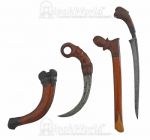We've tried to ensure the information displayed here is as accurate as possible. Should there be any inaccuracies, we would be grateful if you could let us know at info@ipohworld.org . All images and content are copyright.
(Please click on the thumbnail for a bigger image.)
Two Traditional 19th Century Malay Weapons

The Kerambit
Reminiscent of the Tiger’s claw, tis viscous weapon was probably born as am agricultural tool for digging out roots and undertaking small trimming jobs. It was the everyday ‘pocket knife’ of South East Asia, considered to be a weapon for personal defense which, if needed, which could target arteries and joints with ease. Doubly menacing was that it could not be disarmed as a result of its forefinger-grip design.When unsheathed it was often coated with a local poison sourced from snakes, scorpions or spiders, to add to its lethality.
The Kerambit in our collection has a blade 5 inches long and is 9inches when sheathed.
The Tumbuk Lado
This is a traditional weapon across the Malay communities of Indonesia, Borneo and the Malay Peninsula. It has many similarities with other races and ethnicities across South East Asia, but is specifically credited to the Malays of the region.
The Tumbuk Lado is a dagger designed as a stabbing weapon and with its ‘blood line’ (Fullered bkade design) the blade is truly a dangerous weapon. It was traditionally used defensively as a means of defending yourself against attack. With a blade approximately 9 inches long and an overall length of 14 inches sheathed, it is said to symbolizes the courage and valour of man. In modern times the dagger is worn with traditional dress, particularly at weddings and is said to characterize the identity of the Malays although perhaps not to the same extent as the traditional Keris.
The Tumbuk Lado in oour collection has a beautifully carved head of a bird as the handle.
Both weapons play a major part in the tradition of ‘Silat’, the Malay martial art.